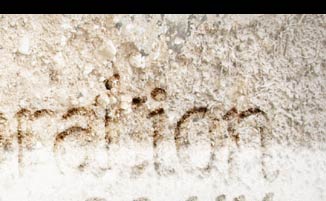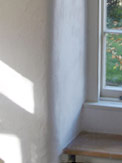
Use of Lime mortars for repairing Period and Listed Buildings
The information on this page is from the Building Conservation website
Gauging Lime Mortars
by Peter Ellis
THE SPECIFICATION OF REPAIR MORTARS
This is a complex issue and each building and its particular condition and problems must be considered individually. There are two considerations that are of paramount importance:
1. The ‘Like-for-Like’ philosophy.In most cases it is technically and aesthetically appropriate to carry out repairs using a mortar to match the existing or original material, replacing like for like. This requires proper analysis to ascertain exactly what material was used, and demands a detailed understanding of materials currently available. This does not imply that poor mortars should be matched, particularly where their use might be harmful to original fabric.
2. Mortars should be durable yet sacrificial to the building fabric.This normally entails preparing the mortar from the constituents required and in the right proportions to ensure that the result is both more porous and more permeable than the stone or brick. This is so that mortars age, decay and ultimately fail before the masonry - hence the term ‘sacrificial’.
THE CHARACTERISTICS OF THE VARIOUS LIME TYPES
1. Non-hydraulic Lime Putty (Fat Limes) Many traditional limes were non-hydraulic, as is most modern lime putty. They set by the reaction with atmospheric carbon dioxide in the presence of moisture alone. A non-hydraulic lime mortar is soft, porous, permeable and plastic. They are used for bedding mortars, for internal and external pointing mortars, and for internal plasters. Internal putty plasters have been and still are on occasion gauged with gypsum to accelerate the set and reduce shrinkage. This was commonly done from c 1760 to ceilings and especially run and cast work, but never to walls where there is a risk of damp as gypsum is slightly soluble in water and sulphate salts migrate and crystallise on the plaster surface.
2. Impure Lime Putty (Lean Limes) Most traditional limes, but sadly few (if any) modern limes fall into this category. They contain impurities such as coal or wood ash, unburnt or partially burnt limestone and a small proportion of reactive silica produced by the de-hydroxylation of clay minerals in the limestone. Some contained a small proportion of di-calcium silicate (C2S). The setting process was principally carbonation augmented by a very weak hydraulic reaction as the C2S hydrates and the silica reacts with lime. The un-converted calcium carbonate and fuel ash also played a positive role. These limes were not as hydraulic as today’s ‘feebly hydraulic’ classification. These limes, supplied as both putty and quicklime, were used to build most things in Britain, including much of London. They were also used for base-coat plasters and external renders.
3. Traditional Hydraulic Limes Certain limestones with high clay mineral content produced hydraulic limes that would be today classified as ‘feebly hydraulic’ (or sometimes possibly moderately hydraulic). The principal examples of these are the Lias limestones from Somerset, Devon, and Aberthaw in South Wales. Arden lime in Scotland is another example. These were invariably supplied as quicklime to be mixed with water and sand on site and used immediately. Putty made from these limes would set quickly, and usage advice for Totternhoe lime, a hydraulic chalk lime from Bedfordshire which was slightly less hydraulic than Lias limes, was to slake only enough on a Friday necessary for the following week’s work.
These traditional hydraulic limes produced durable mortars which were used widely. For example, Lias lime from Devon was used at the Tower of London from the 15th century.
The hydraulicity of the lime produced from these complex raw materials is determined by kiln temperature, and indeed Blue Circle cement is now made from Aberthaw limestone. Traditional kilns rarely got hot enough for complete combination, and the hydraulicity of these limes was largely due to a pozzolanic silica/ lime reaction together with the hydration of limited C2S and C2F (di-calcium ferrite).
4. Modern Hydraulic Hydrates These are produced from clay mineral rich limestones similar to those used to make the traditional hydraulic limes, but once burnt, the material is passed through a hydrating plant, where sufficient water is added to convert the quicklime to calcium hydroxide but not to hydrate the C2S. However, any calcium aluminates are likely to be hydrated by this process. These range in hydraulicity from feebly to eminently hydraulic depending on factors such as kiln temperature and length of time in the kiln, as well as the chemical composition of the limestone. Some of these materials are subsequently blended with pozzolanic additives and in some cases white cement. The Foresight Project2 has identified C3A (tri-calcium aluminate) and C4AF (tetra calcium alumino ferrite) in most types tested indicating kiln temperatures in excess of 1,000 degrees C, hotter than traditional lime kilns. These modern hydrates are therefore more hydraulic than the earlier materials. Available data also suggests an inversely proportional relationship between hydraulicity and permeability.1,8
These hydrates, in particular the less hydraulic grades, have a part to play in historic building repair in applications where reduced porosity and increased strength are advantageous and where reduced vapour permeability is acceptable. These applications include external mortars and renders especially in exposed or aggressive environments. There is less risk of failure when work must proceed in winter as they set more quickly and are thus vulnerable to frost for a shorter period. They are clearly appropriate for repairs to hard mortars such as ‘Roman Cement’, and a better option than cement based mortars. They are rarely appropriate for pointing mortars or internal plasters.
5. Pozzolanic Lime Mortars The durability of pozzolanic lime mortars of correct mix design is proven beyond doubt. A pozzolan is defined as a material that is capable of reacting with lime in the presence of water at ordinary temperatures to produce cementitious compounds. The essential difference between these and modern hydraulic hydrates is that the reaction takes place in solution. The pozzolanic reaction products and the compounds produced on ageing will differ and depend on the calcium to silica ratio in solution. Modern hydraulic hydrates derive their hydraulic properties from the subsequent hydration of compounds of principally calcium and silica produced by solid state reaction in the kiln. The chemistry is of the same chemical nature, but it is not the same.
Pozzolans vary in reactivity, and historically include naturally occurring volcanic Italian pozzolana and Santorini earth as well as artificial forms including brick and tile powder. The varieties most used in the UK are the metakaolin Metastar 501, certain brick dusts of known reactivity and Trass from Germany, but other forms include HTI (ceramic ‘high temperature insulation’) and PFA (‘pulverised fuel ash’). The ground slags are not true pozzolans as they may themselves be cementitious; these are classed as latent hydraulic binders. The addition of ten per cent pozzolan improves durability and strength and slightly reduces porosity and permeability. The pozzolan reacts with the lime and does not set in isolation as occurs when hydraulic lime or cement is added. Pozzolans are added to lime putty mortars where there is doubt about durability and the reduced porosity is not disadvantageous.
To quote Vitruvius from De Architectura in the first century BC: ‘If to river or sea sand, potsherds ground and passed through a sieve, in the proportion of one third part, be added, the mortar will be the better for use.’
More advice can on mix ratios can be found here >
More general lime advice can be found on the main 'Why use Lime' page »












